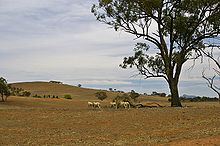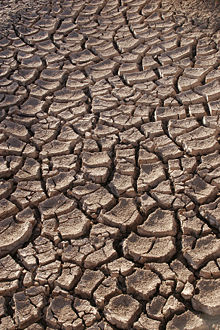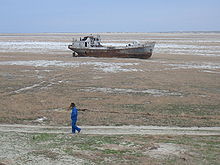- Drought
-
For other uses, see Drought (disambiguation).
A drought (or drouth [archaic]) is an extended period of months or years when a region notes a deficiency in its water supply. Generally, this occurs when a region receives consistently below average precipitation. It can have a substantial impact on the ecosystem and agriculture of the affected region. Although droughts can persist for several years, even a short, intense drought can cause significant damage[1] and harm the local economy.[2]
This global phenomenon has a widespread impact on agriculture. The United Nations estimates that an area of fertile soil the size of Ukraine is lost every year because of drought, deforestation, and climate instability.[3] Lengthy periods of drought have long been a key trigger for mass migration and played a key role in a number of ongoing migrations and other humanitarian crises in the Horn of Africa and the Sahel.
Contents
Consequences
Periods of drought can have significant environmental, agricultural, health, economic and social consequences. The effect varies according to vulnerability. For example, subsistence farmers are more likely to migrate during drought because they do not have alternative food sources. Areas with populations that depend on as a major food source are more vulnerable to drought-triggered famine.
Drought can also reduce water quality, because lower water flows reduce dilution of pollutants and increase contamination of remaining water sources. Common consequences of drought include:
- Diminished crop growth or yield productions and carrying capacity for livestock
- Dust bowls, themselves a sign of erosion, which further erode the landscape
- Dust storms, when drought hits an area suffering from desertification and erosion
- Famine due to lack of water for irrigation
- Habitat damage, affecting both terrestrial and aquatic wildlife[4]
- Malnutrition, dehydration and related diseases
- Mass migration, resulting in internal displacement and international refugees
- Reduced electricity production due to reduced water flow through hydroelectric dams[5]
- Shortages of water for industrial users[6][7]
- Snake migration and increases in snakebites[8]
- Social unrest
- War over natural resources, including water and food
- Wildfires, such as Australian bushfires, are more common during times of drought[9]
Globally
Drought is a normal, recurring feature of the climate in most parts of the world. It is among the earliest documented climatic events, present in the Epic of Gilgamesh and tied to the biblical story of Joseph's arrival in and the later Exodus from Ancient Egypt.[10] Hunter-gatherer migrations in 9,500 BC Chile have been linked to the phenomenon,[11] as has the exodus of early man out of Africa and into the rest of the world around 135,000 years ago.[12]
Modern peoples can effectively mitigate much of the impact of drought through irrigation and crop rotation. Failure to develop adequate drought mitigation strategies carries a grave human cost in the modern era, exacerbated by ever-increasing population densities.
Regions
 Sheep on a drought affected paddock near Uranquinty, New South Wales.
Sheep on a drought affected paddock near Uranquinty, New South Wales.
Recurring droughts leading to desertification in the Horn of Africa have created grave ecological catastrophes, prompting massive food shortages, still recurring.[15] To the north-west of the Horn, the Darfur conflict in neighboring Sudan, also affecting Chad, was fueled by decades of drought; combination of drought, desertification and overpopulation are among the causes of the Darfur conflict, because the Arab Baggara nomads searching for water have to take their livestock further south, to land mainly occupied by non-Arab farming peoples.[16]
Approximately 2.4 billion people live in the drainage basin of the Himalayan rivers.[17] India, China, Pakistan, Bangladesh, Nepal and Myanmar could experience floods followed by droughts in coming decades. Drought in India affecting the Ganges is of particular concern, as it provides drinking water and agricultural irrigation for more than 500 million people.[18][19][20] The west coast of North America, which gets much of its water from glaciers in mountain ranges such as the Rocky Mountains and Sierra Nevada, also would be affected.[21][22]
In 2005, parts of the Amazon basin experienced the worst drought in 100 years.[23][24] A 23 July 2006 article reported Woods Hole Research Center results showing that the forest in its present form could survive only three years of drought.[25][26] Scientists at the Brazilian National Institute of Amazonian Research argue in the article that this drought response, coupled with the effects of deforestation on regional climate, are pushing the rainforest towards a "tipping point" where it would irreversibly start to die. It concludes that the rainforest is on the brink of being turned into savanna or desert, with catastrophic consequences for the world's climate. According to the WWF, the combination of climate change and deforestation increases the drying effect of dead trees that fuels forest fires.[27]
By far the largest part of Australia is desert or semi-arid lands commonly known as the outback. A 2005 study by Australian and American researchers investigated the desertification of the interior, and suggested that one explanation was related to human settlers who arrived about 50,000 years ago. Regular burning by these settlers could have prevented monsoons from reaching interior Australia.[28] In June 2008 it became known that an expert panel had warned of long term, maybe irreversible, severe ecological damage for the whole Murray-Darling basin if it does not receive sufficient water by October.[29] Australia could experience more severe droughts and they could become more frequent in the future, a government-commissioned report said on July 6, 2008.[30] The Australian of the year 2007, environmentalist Tim Flannery, predicted that unless it made drastic changes, Perth in Western Australia could become the world’s first ghost metropolis, an abandoned city with no more water to sustain its population.[31]
East Africa currently faces its worst drought in decades,[32][33] with crops and livestock destroyed.[34] The U.N. World Food Programme recently said that nearly four million Kenyans urgently needed food.[35]
Causes
 A Mongolian gazelle dead due to drought .
A Mongolian gazelle dead due to drought .
Generally, rainfall is related to the amount of water vapor in the atmosphere, combined with the upward forcing of the air mass containing that water vapor. If either of these are reduced, the result is a drought. This can be triggered by an above average prevalence of high pressure systems, winds carrying continental, rather than oceanic air masses (i.e. reduced water content), and ridges of high pressure areas form with behaviors which prevent or restrict the developing of thunderstorm activity or rainfall over one certain region. Oceanic and atmospheric weather cycles such as the El Niño-Southern Oscillation (ENSO) make drought a regular recurring feature of the Americas along the Midwest and Australia. Guns, Germs, and Steel author Jared Diamond sees the stark impact of the multi-year ENSO cycles on Australian weather patterns as a key reason that Australian aborigines remained a hunter-gatherer society rather than adopting agriculture.[36] Another climate oscillation known as the North Atlantic Oscillation has been tied to droughts in northeast Spain.[37]
Human activity can directly trigger exacerbating factors such as over farming, excessive irrigation,[38] deforestation, and erosion adversely impact the ability of the land to capture and hold water.[39] While these tend to be relatively isolated in their scope, activities resulting in global climate change are expected to trigger droughts with a substantial impact on agriculture[40] throughout the world, and especially in developing nations.[41][42][43] Overall, global warming will result in increased world rainfall.[44] Along with drought in some areas, flooding and erosion will increase in others. Paradoxically, some proposed solutions to global warming that focus on more active techniques, solar radiation management through the use of a space sunshade for one, may also carry with them increased chances of drought.[45]
Types of drought
As a drought persists, the conditions surrounding it gradually worsen and its impact on the local population gradually increases. People tend to define droughts in three main ways:[46]
- Meteorological drought is brought about when there is a prolonged period with less than average precipitation. Meteorological drought usually precedes the other kinds of drought.
- Agricultural droughts are droughts that affect crop production or the ecology of the range. This condition can also arise independently from any change in precipitation levels when soil conditions and erosion triggered by poorly planned agricultural endeavors cause a shortfall in water available to the crops. However, in a traditional drought, it is caused by an extended period of below average precipitation.
- Hydrological drought is brought about when the water reserves available in sources such as aquifers, lakes and reservoirs fall below the statistical average. Hydrological drought tends to show up more slowly because it involves stored water that is used but not replenished. Like an agricultural drought, this can be triggered by more than just a loss of rainfall. For instance, Kazakhstan was recently awarded a large amount of money by the World Bank to restore water that had been diverted to other nations from the Aral Sea under Soviet rule.[47] Similar circumstances also place their largest lake, Balkhash, at risk of completely drying out.[48]
Drought protection and relief
 The effects of the drought brought on by El Niño. Waiting for water distribution (Ebeye, Marshall Islands.)
The effects of the drought brought on by El Niño. Waiting for water distribution (Ebeye, Marshall Islands.)
Strategies for drought protection, mitigation or relief include:
- Dams - many dams and their associated reservoirs supply additional water in times of drought.
- Cloud seeding - an artificial technique to induce rainfall.[49]
- Desalination of sea water for irrigation or consumption.
- Drought monitoring - Continuous observation of rainfall levels and comparisons with current usage levels can help prevent man-made drought. For instance, analysis of water usage in Yemen has revealed that their water table (underground water level) is put at grave risk by over-use to fertilize their Khat crop.[50] Careful monitoring of moisture levels can also help predict increased risk for wildfires, using such metrics as the Keetch-Byram Drought Index[9] or Palmer Drought Index.
- Land use - Carefully planned crop rotation can help to minimize erosion and allow farmers to plant less water-dependent crops in drier years.
- Outdoor water-use restriction - Regulating the use of sprinklers, hoses or buckets on outdoor plants, filling pools, and other water-intensive home maintenance tasks.
- Rainwater harvesting - Collection and storage of rainwater from roofs or other suitable catchments.
- Recycled water - Former wastewater (sewage) that has been treated and purified for reuse.
- Transvasement - Building canals or redirecting rivers as massive attempts at irrigation in drought-prone areas.
See also
- Climate change
- Collapse: How Societies Choose to Fail or Succeed
- FEMA
- Food security
- Permanent wilting point
- Topsoil
- United Nations Convention to Combat Desertification
- Water conflict
- Water crisis
Regional:
- Amazon Rainforest drought
- Droughts and famines in Russia and USSR
- Drought in Australia, Exceptional Circumstances relief payments
- Drought in the United Kingdom
- Drought in the United States
- Maya collapse
- Sahel drought
References
- ^ Living With Drought
- ^ Australian Drought and Climate Change, retrieved on June 7th 2007.
- ^ 2008: The year of global food crisis
- ^ C.Michael Hogan. 2010. Abiotic factor. Ed. Emily Monosson. Encyclopedia of Earth. National Council for Science and the Environment, Washington DC
- ^ Drought affecting US hydroelectric production | Daily Estimate
- ^ Parched village sues to shut tap at Coke March 6, 2005
- ^ [http://www.greenpeace.org/international/news/sweden-nuclear-closure-040806 Greenpeace reports on a Swedish drought and its potential impact on their nuclear industry. 4 August 2006]
- ^ Australians Face Snake Invasion.
- ^ a b Texas Forest Service description of the Keetch-Byram Drought Index (KBDI) from 27 December 2002
- ^ BBC - Weather Centre - Features - History and Religion - Weather in the Bible - Drought and Famine
- ^ Ancient Chile Migration Mystery Tied to Drought
- ^ Drought pushed ancient African immigration
- ^ Disappearing Lakes, Shrinking Seas
- ^ Shrinking African Lake Offers Lesson on Finite Resources
- ^ Sara Pantuliano and Sara Pavanello (2009) Taking drought into account Addressing chronic vulnerability among pastoralists in the Horn of Africa Overseas Development Institute
- ^ Looking to water to find peace in Darfur
- ^ Big melt threatens millions, says UN
- ^ Ganges, Indus may not survive: climatologists
- ^ Glaciers melting at alarming speed
- ^ Himalaya glaciers melt unnoticed
- ^ Glaciers Are Melting Faster Than Expected, UN Reports
- ^ Water shortage worst in decades, official says, Los Angeles Times
- ^ Environmental News Service - Amazon Drought Worst in 100 Years
- ^ Drought Threatens Amazon Basin - Extreme conditions felt for second year running
- ^ Amazon rainforest 'could become a desert' , The Independent, July 23, 2006. Retrieved September 28, 2006.
- ^ Dying Forest: One year to save the Amazon, The Independent, July 23, 2006. Retrieved September 28, 2006.
- ^ Climate change a threat to Amazon rainforest, warns WWF, World Wide Fund for Nature, March 22, 2006. Retrieved September 28, 2006.
- ^ Sensitivity of the Australian Monsoon to insolation and vegetation: Implications for human impact on continental moisture balance, Geological Society of America
- ^ Australian rivers 'face disaster', BBC News
- ^ Australia faces worse, more frequent droughts: study, Reuters
- ^ Metropolis strives to meet its thirst, BBC News
- ^ "East Africa's drought: A catastrophe is looming". The Economist. September 24, 2009.
- ^ "Kenya drought sparks deadly clashes". ABC News. September 21, 2009.
- ^ "Kenya Devastated by Massive Drought". PBS NewsHour. October 13, 2009.
- ^ "Lush Land Dries Up, Withering Kenya’s Hopes". The New York Times. September 9, 2009.
- ^ Guns, Germs, and Steel by Jared Diamond 1997, pgs 308-309
- ^ Sergio M. Vicente-Serrano & José M. Cuadrat (2007-03-14). "North Atlantic oscillation control of droughts in north-east Spain: evaluation since 1600 A.D.". Climatic Change 85 (3–4): 357–379. doi:10.1007/s10584-007-9285-9. https://www.cfa.harvard.edu/~wsoon/ChristopherMonckton08-d/Vicente-SerranoCuadrat07-NAOonNESpainDroughts.pdf. Retrieved 2010-11-23.
- ^ A biblical tragedy as Sea of Galilee faces drought Belfast Telegraph
- ^ Kenya: Deforestation exacerbates droughts, floods
- ^ NOAA Drought and climate change: implications for the West December 2002
- ^ Record rise in wheat price prompts UN official to warn that surge in food prices may trigger social unrest in developing countries
- ^ Fuel costs, drought influence price increase
- ^ Nigerian Scholar Links Drought, Climate Change to Conflict Africa Oct, 2005
- ^ Is Water the New Oil?
- ^ Sunshade' for global warming could cause drought 2 August 2007 New Scientist, Catherine Brahic
- ^ NOAA factsheet, retrieved April 10, 2007
- ^ BBC article on the World Bank loan to save the Aral Sea
- ^ BBC article from 2004 concerning the risk of Kazakhstan losing the lake
- ^ Cloud seeding helps alleviate drought
- ^ BBC's From Our Own Correspondent on khat water usage
External links
- Water scarcity from FAO Water (Food and Agriculture Organization of the United Nations)
- US Drought Monitor Current U.S. drought conditions
- US Economic Costs of Drought NOAA Economics
- Catastrophic drought is coming back, Brian M. Fagan lecture for the Long Now Foundation (MP3)
Natural disasters Land movement Water Weather Fire Health and diseases Space Disasters Overview Disasters NaturalList of environmental disasters • Tornado • Drought • Mudslide • Flood • Tropical cyclone • Earthquake • Historic fires • Forest fires • Impact eventTransportIndustrialStructural failures and collapses • Bridge • Dam • Nuclear • Nuclear and radiation by death toll • Civilian radiation • Civilian nuclear • Military nuclear • Oil spills • Levee • Mast and tower • Infrastructure • SpaceHealthWars and anthropogenic disasters • Battles and other violent events • Military • Wars • Terrorist incidents • Riots • MassacresCountermeasures Media Feature films • DocumentariesOrganizations Global Risk Forum GRF Davos • International Association of Emergency Managers • International Disaster and Risk Conference • Disaster Accountability Project • International Disaster Emergency ServicePortal: Disasters Categories:- Basic meteorological concepts and phenomena
- Climatology
- Droughts
- Hydrology
- Weather hazards
Wikimedia Foundation. 2010.




